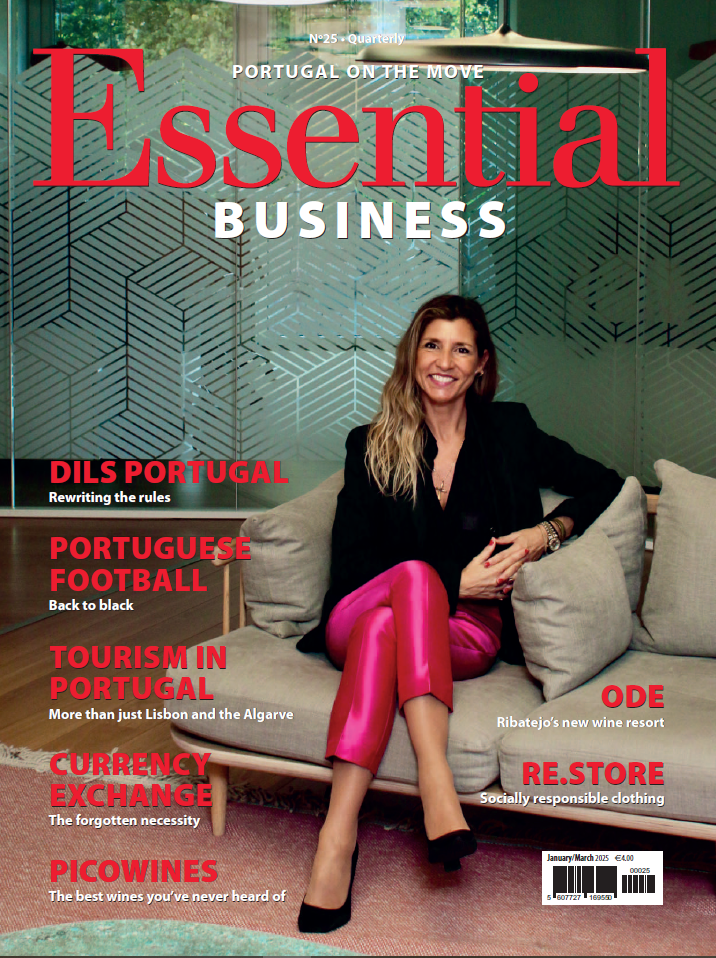Kabuki – Japanese haute cuisine with a Portuguese twist
If you like Japanese fine dining with a Portuguese and Mediterranean twist, Essential Business recommends Kabuki, a Michelin star restaurant in the centre of Lisbon that won’t disappoint.
Text: Chris Graeme Photo: Arlei Lima
Portugal and Japan have always had close historic ties which stretch back to the mid-16th century when Portuguese sailors first arrived in Japan in 1543.
The Portuguese legacy in Japan includes a gastronomic heritage such as tempura or various sweet dishes like conceit or the castella cakes from Nagasaki.
It is no surprise then that Japanese-inspired cuisine has continued to be popular in Portugal, even more so over the past 20 years when a plethora of Japanese restaurants serving up sushi, sashimi, ramen, yakitori, oden and sukiyaki have mushroomed in the country’s main cities such as Lisbon and Porto.
I was invited to enjoy a fine Japanese luncheon experience at the Michelin star restaurant Kabuki in the Ritz Galleries running contiguous to the Ritz Four Seasons Hotel off Lisbon’s central Marquês de Pombal; an area packed with five-star hotels, shops, restaurants and offices, and providing no lack of hungry tourists and office workers on a limited lunch hour who want to simply dine and dash.
The restaurant’s name is somewhat a misnomer. There is no dish or cuisine called Kabuki which is, in fact, a classical form of Japanese theatre known for its heavily stylised performances and glamorous, highly decorated costumes.
A golden glow
The restaurant’s interiors are anything but glamorous, elaborate or theatrical. Instead, severe and clean lines dominate the décor dominated by wooden beams and slatted walls with furnishing and colour schemes that while cosy for the evening are predominantly brown, beige and somewhat dark in the day, except for the bar area which has a golden glow enhanced by clever lighting, particularly behind the translucent marble bar.
This area, where you can enjoy a Japanese-inspired cocktail – I went for the Tokyo Blossom; an egg flip concoction laced with sake with lemony and flora overtones — while waiting to be shown through to your table next door, has interesting walls that tell different stories throughout the year; indeed, it acts as an unofficial art gallery.
Where art meets art
Thirteen works by the artist Tomek Sadurski grace the walls — the exhibition actually ended at the end of May – but is part of a wider art concept aimed at offering diners a multi-sensory experience since food, with its blend of fragrance, colour, texture and taste, is art and the chef who designs and conceives it is clearly just as much an artist as the person who toils on the carefully created art pieces displayed on walls.
It was here I had the chance to learn more about the dining concept and the Spanish group Kabuki which has four restaurants in Spain – two in Madrid, one in Malaga and another on the island of Gran Canaria.
The group chose to partner with the Ritz Four Seasons for its first restaurant outside Spain; indeed, the company’s strategy was to have restaurants within hotels because it was a win-win situation for both the hotel and Kabuki.
The bulk of the clientele is Portuguese (60%) with hotel guests and tourists making up the remaining 40%.
The restaurant itself is not in or part of the hotel, but in the shopping gallery beneath offices which are managed by the hotel group.
In each location where the restaurants are there is an attempt to adapt the Japanese dishes and culinary techniques to local tastes and realities; in this case Japanese cuisine with Portuguese flavours, but this is not to say it is fusion cuisine by definition.
“When Kabuki arrived here, we immediately realised that the Portuguese were looking for authentic classic Japanese Edomae sushi cuisine. So, we have options that have a more Portuguese twist and the classic to suit the purists”, explained Kabuki Director of Marketing, Marta Flores Seabra.
Three different spaces
The restaurant features three main spaces: the bar — where I sip my cocktail and munch on wasabi popcorn — called Kikubari, the restaurant Kabuki and a private room reserved for unique experiences and private functions like international wine tastings.
Kabuki does around 20 covers at lunchtime served in the upstairs restaurant which is flooded with natural light and looks on to the Parque Eduardo VII park. The restaurant has separate rooms for lunch and dinner. At night the downstairs restaurant, which has a capacity for 50 diners, features a long bar with an open kitchen concept where clients can see their food freshly prepared in front of them.
Kabuki, which has already enjoyed much success in Madrid, opened in Lisbon during the Covid-19 pandemic in 2021 and quickly established a name for itself when the then chef Paulo Alves, who had already made a name for himself in the fine art of Japanese cuisine at Avenida SushiCafé, surprised with a menu that combined Japanese, Portuguese and Mediterranean concepts and flavours that clearly delighted those incognito Michelin mystery diners who awarded the eatery with its star.
And to keep the new-found name and fame clearly in the public’s consciousness, Kabuki began staging high-profile events such as Chefs on Fire producing special dinner menus with other local celebrity chefs like André Cruz (Feitoria) and Diogo Formiga (Encanto).
A Michelin gourmet experience
Kabuki still retains the prestigious Michelin star this year thanks to the new chef Sebastião Coutinho – he had been sous chef under Paulo Alves – who serves us up a lunch menu comprising starters, a main course and desserts designed for the busy person on the hoof.
Sushi was not on the menu that day for me, instead opting for the Bento Box for starters which is presented like a chocolate box; each compartment containing mouth-watering bite-size amuse bouche dainties which are as varied in their colours and textures as they are in their flavours.
This was followed by six dishes of ‘moments’ including Uzuzukuri of scallops with cumin sauce and Miso Shiru, a fermented soya soup with algae served in a charming ceramic bowl. For the main course — many are dominated by fish – I selected the Moriawase with white fish, salmon and tuna. The meal was rounded off with a sweet touch from the traditional Japanese dessert Mochi. It is Chef Sebastião’s take on the traditional Japanese rice cake made of mochigome — a short-grain japonica glutinous rice, and sometimes other ingredients such as water, sugar, and cornstarch.
The steamed rice is pounded into paste and molded into the desired shape. In Japan, it is traditionally made in a ceremony called mochitsuki. While eaten year-round, mochi is a traditional food for the Japanese New Year and is commonly sold and eaten during that time.
Some of my colleagues plumped for an amazing selection of nigiri including belly of tuna with truffled quail eggs and a wagyu meat dish served with teriyaki sauce.
And if you are vegetarian, fear not, Kabuki has you covered with a dedicated vegan menu with vegetable tempuras, Chinese cabbage, breaded tofu schnitzels, and spicy avocad and a rich tofu and chocolate cherry desert.
The food is exciting, varied and creative, using locally caught fish and seafood, although there are meat dishes on the menu such as Galician beef served with mushrooms, and steak tartare, but really, does anyone seriously spend from €45 upwards to €200 for an executive experience (including wine) on a fine Japanese dining experience and order beef?
Portuguese flavours are skilfully blended with some of the dishes to reflect the long-standing ties between the two countries’ culinary traditions, including a Bulhão Pato Usuzukuri or Scarlet Prawn Usuzukuri, Sardine Nigiri, Guindara No Miso and even Pastel de Nata Mochi are proof of this and have already become favourites with some of their regular diners.
Incredible dishes with simplicity
The gourmet experience was completed with an opportunity to chat with Sebastião Coutinho who has been fascinated by Japanese cuisine since he was kid and explains the concept of the menu to us.
Sebastião’s professional journey has always been in Portugal although he has travelled around Japan which fired his enthusiasm and spurred him to open his own restaurant in Oeiras.
Menus are changed annually although more frequent adjustments are made according to the seasons and produce available. He tells us he is currently working on a new menu which went on to be launched May.
The menus have been developed to suit all tastes, time requirements and pockets, including the executive menu for businesspeople who drop in for lunch, a tasting menu for those who want to try a wide selection of dishes and flavours but keep it light, and a full à la carte menu for a totally immersive gourmet experience.
“Since I started working in kitchens, I have always worked with Japanese cuisine with a Portuguese touch, so Kabuki is the perfect experience for me,” says Sebastião adding that he has mostly worked in Portugal but did do a spell in Nantucket in the USA.
“I am fascinated by everything Japanese, starting with the culture, the importance they place on products and the essence of them unlike French cuisine which tends to be fussy compared to Japanese cuisine which is very clean. I like to do incredible dishes but employing simplicity.”
Sebastião points out that it is almost impossible for any Japanese cuisine chef to 100% replicate the dishes as they would be consumed in Japan because “you simply cannot get all the ingredients”, particularly some of the fish, which should be fresh and acquired the same day.
The chef says that the aspect of Kabuki-style of Japanese cuisine has a long history having started in Spain 20 years ago, but he places an emphasis of always trying to improve and keep the concept fresh and modern.
“We’ve only been in Portugal for two years and our goal is to make the cuisine more Portuguese, reflecting my personal touch so that as time goes on there will be clear differences between the style served in Madrid and here in Lisbon, and that is what will make us unique and special,” concludes Chef Sebastião Coutinho.










